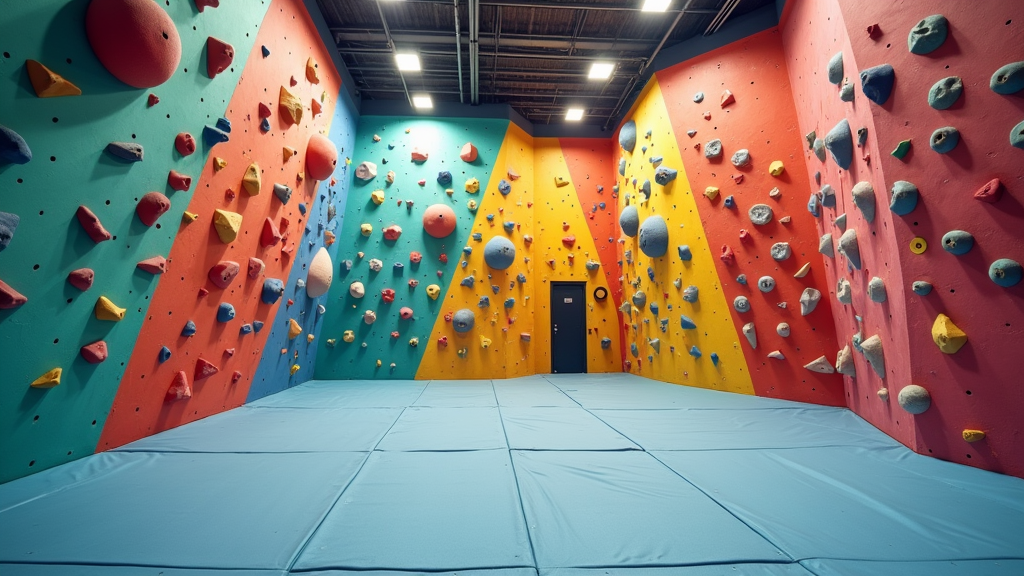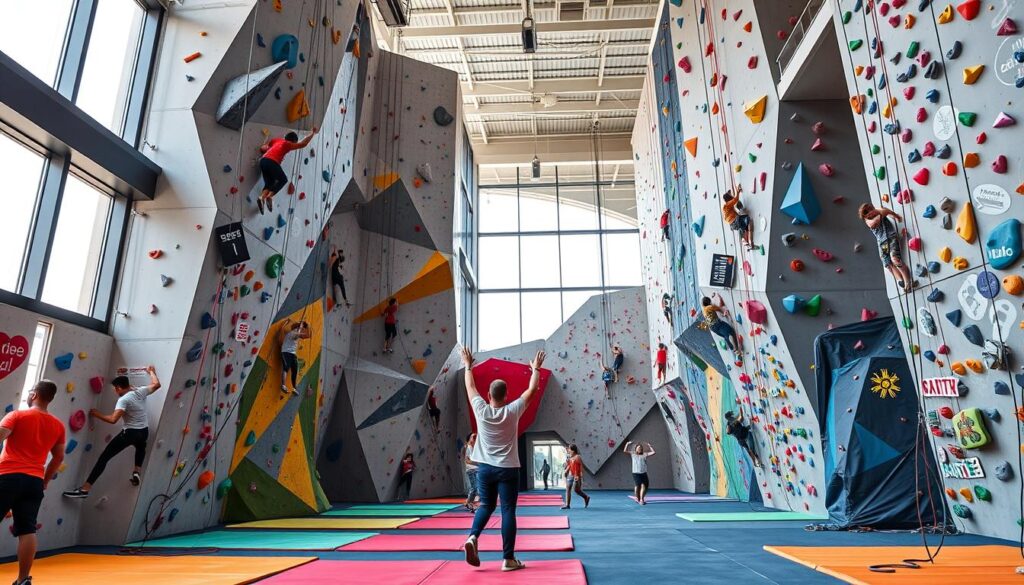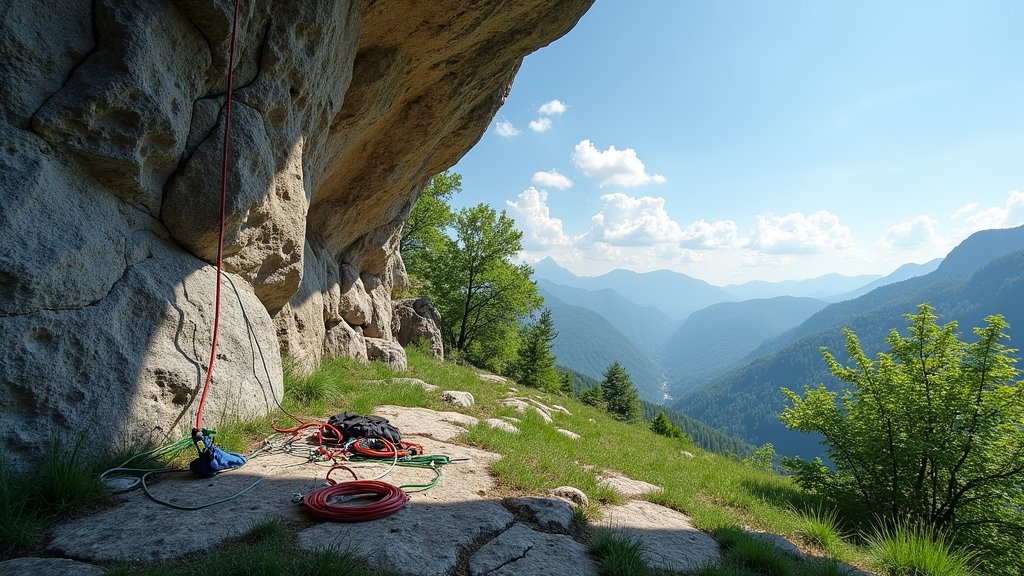🌄No experience? No problem. Every expert climber once stood at the bottom too — here’s how to start your own vertical journey.
Rock climbing is an exciting way to shake up your fitness routine, meet adventurous people, and test both your mind and your muscles.
Try it for the first time and be genuinely surprised by how welcoming the climbing community really is. Now there’s a lot to learn and when you’re just getting started, all the talk about climbing grades, gear, and techniques can feel a little overwhelming.
That’s why I’ve putting together this beginner’s guide to help you get a solid grip on the basics and make your introduction way smoother.

Getting Started: Understanding the Types of Rock Climbing
It’s pretty handy to know there are a few different ways people climb. Figuring out what interests you helps you focus on the right skills and gear from day one.
- Bouldering: This style focuses on short, challenging routes (called “problems”) without ropes, usually on walls up to about 16 feet (5 meters). Soft mats below cushion your fall. It’s a fantastic place to start since you don’t need tons of equipment.
- Top Rope Climbing: Here, you’re harnessed in and attached to a rope that runs up and over the wall. Someone on the ground (“the belayer”) manages the rope, keeping you safe if you slip. Great for beginners ready to climb higher.
- Lead Climbing: More advanced, this style has you clipping the rope into protection points as you climb. It’s thrilling but best tried once you’ve learned the basics.
- Outdoor Climbing: Most gyms train you for climbing indoors, but many people love taking their skills outdoors for real rock faces and bigger adventures. Outdoor climbing includes everything from sport climbs to multipitch alpine climbs and even ice climbing in winter.
The Basic Gear Every Climber Needs
Before getting too deep, knowing what gear is really necessary is a smart call, especially to avoid spending cash on stuff you don’t need yet.
- Climbing Shoes: These fit tighter than normal sneakers and help you use small holds. Comfort matters more than ultra-tight fits for your first pair.
- Chalk Bag: Climbing chalk keeps your hands dry so you don’t slip. A small bag that clips to your waist works great for both bouldering and roped climbing.
- Harness: Needed for roped climbing, harnesses go around your waist and legs. Comfort and a snug fit are what to always look for.
- Belay Device and Locking Carabiner: Used for controlling the rope when you or your partner is climbing. Most gyms will teach you the basics and provide rental gear at first.
- Helmet: More common outdoors but worth using especially outside to protect from rocks or dropped gear.
For your first sessions in a gym, most places rent all this at the front desk. Once you decide you’re in it for the long run, investing in your own gear makes a lot of sense both for comfort and hygiene.
Some climbers also eventually pick up a brush for cleaning holds, tape for wrapping fingers, and a small first-aid kit for scrapes. For outdoor climbing, extra gear like ropes, quickdraws, and trad protection gets added to your setup later.
Understanding Climbing Gyms and Wall Features
Stepping into a climbing gym, you’ll spot different walls, shapes, and tons of colourful holds. Here’s the main features you’ll run into:
- Climbing Holds: These are the plastic or resin pieces bolted onto walls in all sorts of shapes—jugs (big holds), crimps (tiny edges), slopers (rounded), and pockets. Each style trains a different grip and muscle set.
- Bouldering Zones: Usually have thick mats and shorter walls. Every route is marked with tape or coloured holds so you know which challenges to try.
- Top Rope Walls: Much higher with ropes already anchored overhead. You’ll see people belaying each other and calling out commands.
- Lead Walls: Feature longer, steeper routes with quickdraws (protection points). These offer a cool step up once you feel steady on the basics.
Most gyms host intro classes that teach you about the space, safety, and essential climbing commands. Gyms also have weight training or stretching areas, couches to hang out, and bulletin boards showing local climbing groups or outdoor trip options.
Checking out these resources can level up your experience and help you spot new friends quickly. Don’t forget to check your local gym’s schedule for workshops on technique or climbing-specific yoga and stretching, which can boost your flexibility and movement comfort on the wall.
Key Climbing Techniques and Training Basics
Climbing isn’t just about pulling as hard as possible. There’s real skill behind footwork, balance, and efficiency. When starting out, focusing on these basics make things way easier on your arms and more fun overall:
- Using Your Feet: Try to “stand up” on your legs rather than hauling yourself up with your arms. Good footwork saves a lot of energy.
- Body Position: Keeping your hips close to the wall and turning your body helps you reach difficult holds more easily.
- Resting: Find rest positions on climbs to shake out your arms and relax tired muscles. Mushrooms (rounded, bulbous-shaped hold that sticks out from the wall — resembling a mushroom cap) and jugs (big holds) are perfect for a quick breather.
- Bouldering Circuits: Going through several easy problems at once helps build endurance before jumping into trickier routes.
Adding some basic climbing exercises, like hang boarding and pullups, helps if you want more power, but focusing on movement and technique first is usually best for beginners. Another tip: try watching strong climbers and copying their moves (of course don’t try anything too advanced or difficult at first, to avoid injuries).
another thing that can help is taking videos of yourself to get a sense of your body position, foot placement, and ways to save energy. This self-feedback can be surprisingly effective in speeding up your improvement and keeping things interesting.
Climbing Grades: Figuring Out Which Climbs to Try
Climbs have a “grade” or difficulty rating. In the US, you’ll see the V-scale for bouldering (V0, V1, V2, etc.) and the Yosemite Decimal System (5.5, 5.9, 5.10a, etc.) for roped climbs. Lower numbers are easier, and the scale is open-ended. Climbing grades feel different everywhere, so don’t sweat the numbers too much at first.
If and when you’re ready, try and pick climbs that feel a little challenging but not overwhelming, and try climbs on different walls to break up your routine. Remember, the grade is just a guideline and doesn’t measure your progress as well as personal challenges do. Enjoy the process instead of obsessing over the numbers.
Safety and Climbing Etiquette
Staying safe isn’t just about gear; it’s about paying attention and respecting other climbers. A few basics make a big difference:
- Always warm up and stretch before climbing. This will loosen up your body and help avoid cramps or injuries.
- Double-check your knots and harness if you’re climbing with ropes.
- Be aware of people climbing above or below you, especially in a busy gym.
- Watch out for dropped gear and let others know if you drop something accidentally.
- Respect route setting and don’t rearrange holds in gyms.
Gyms and outdoor areas usually have posted rules; checking these out keeps everyone safe and makes sure you’re seen as a good climbing partner.
Good etiquette also means sharing the wall, being patient if another climber is working on the route you want, and avoiding loud distractions.
If you travel to different gyms or outdoor areas, always follow their unique guidelines and help keep the space clean for everyone.
Beginner Tips for Fast Progress
- Take Intro Classes: These classes teach you to belay, use gear, and climb with good form. Even one session can give you loads of confidence.
- Climb with Different People: You’ll pick up lots of tips and encouragement by joining the community, whether at the gym or in a local climbing club.
- Try a Variety: Mixing bouldering and roped climbing helps you see where you have the most fun and where you want to push yourself.
- Listen to Your Body: Rest when needed. Climbing works muscles you might not even know you had.
- Have Fun: Progress happens at your own pace. Celebrate small victories, like finishing your first V0 problem or tying a figure-eight knot by yourself.
Building friendships with fellow climbers can also make your climbing more rewarding. Regular partners often help you get over plateaus and encourage you to try new challenges you might have skipped before.
It’s also wise to read up on basic injury prevention, like finger care, and always cool down and stretch after a climbing session to help your body recover faster.

The Climbing Community: Events, Clubs, and More
One of the coolest things about climbing is the sense of community. Many gyms host events, friendly competitions, and meetups for climbers of all skill levels. Joining a climbing club or attending local outdoor trips can open up new friendships, adventure buddies, and even a mentor or two. Sharing beta (tips on climbing a route) and stories is part of what makes climbing gyms feel welcoming.
Competitions (sometimes called “comps”) are common in gyms and are usually more about fun and trying your best than actual rivalry. These events are popular for testing your skills and meeting others at your level.
If you want to get more involved, check out online forums or social media groups where local climbers plan outdoor meetups or gear swaps. This is a great way to stumble upon new resources, safety workshops, and ride-sharing arrangements for climbing trips.
Frequently Asked Questions
Q: Do I need to be super fit to start climbing?
A: Nope! Rock climbing builds strength and fitness over time. Beginners of all fitness levels learn more from learning movement and technique than brute force. It’s a great way to get stronger gradually.
Q: How do I find a good climbing gym?
A: Look for local gyms with user-friendly routes, intro classes, and rental gear. Reading reviews and dropping by for a tour helps you find a spot that matches your vibe. You can also ask staff for their favourite beginner routes and local events to jump right into the scene.
Q: Is outdoor climbing very different from climbing in a gym?
A: Yes! Outdoor climbing brings its own challenges, including different types of rock, more complex safety concerns, and changing conditions.
It’s best to learn indoors first, then go outdoors with an experienced group or instructor. Many outdoor groups welcome newbies, and local organizations often host intro courses to cover essential skills and outdoor ethics.
Health Benefits and Challenges of Climbing
Climbing is awesome for full-body strength, flexibility, and even mental wellbeing. Topping out on a route can feel way more satisfying than ticking off a goal on a treadmill and personally, I’d take activities like climbing over traditional cardio any day.
At the same time, there are challenges like sore muscles, skin that needs to toughen up, and learning to manage your fears.
Regular stretching, hydration, and listening to your body help you bounce back quicker after a tough session and always remember, making mistakes is part of climbing, and each fall or slip is a step forward in learning.
If you’re mindful about your body’s limits, climbing can be a lifelong hobby. Always take rest days when sore and check in with a health professional if you experience pain that doesn’t let up.
The problem-solving aspect of climbing can also support cognitive health and self-confidence, making every trip to the gym a boost not just for your body but your mind as well.
Stepping into the world of rock climbing opens up more than just a new way to exercise. It’s a sweet combo of physical fitness, problem-solving, adventure, and social fun.
Whether you’re bouldering at your local gym, mastering your first top rope route, or dreaming of outdoor alpine climbs, there’s plenty of excitement (and community) waiting for you. So go grab those shoes, chalk up, and chase that next adventure!
⚡From first climbs to fearless ascents, Adventure Nirvana is where your vertical story begins. Strap in, grip tight and trust your step. Show this world what you’re capable of. 🧗💪

